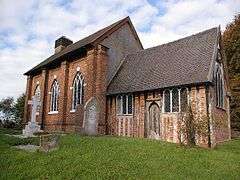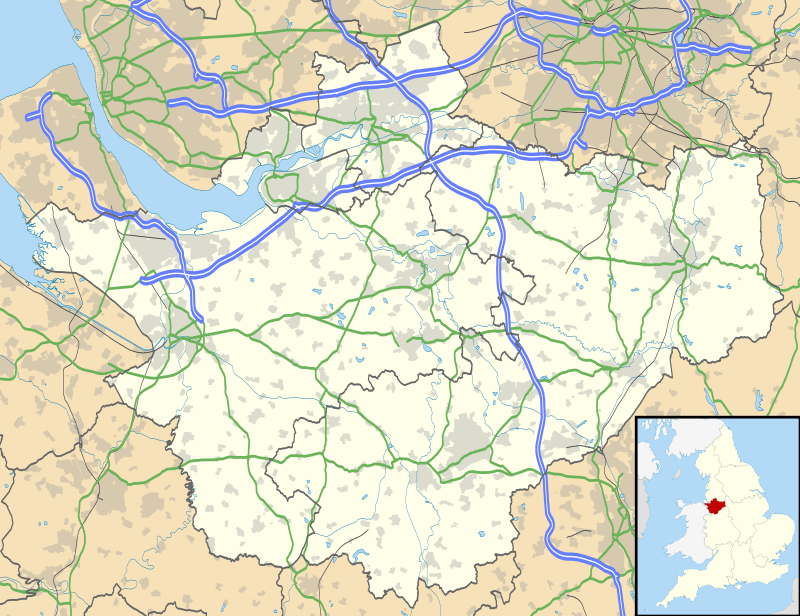St Michael's Church, Baddiley
St Michael's Church is in the civil parish of Baddiley, Cheshire, England. It is recorded in the National Heritage List for England as a designated Grade I listed building.[1] The church lies at the end of a lane near to Baddiley Hall, formerly the home of the Mainwaring family.[2][3] It dates from the early 14th century. The nave and chancel are divided by a pre-Reformation screen and tympanum. The church is one of a 'handful' of timber-framed churches remaining in the country.[4] It continues to be an active Anglican parish church in the diocese of Chester, the archdeaconry of Macclesfield and the deanery of Nantwich. Its benefice is combined with those of St Mary's and St Michael's Church, Burleydam and St Margaret's Church, Wrenbury.[5]
| St Michael's Church, Baddiley | |
|---|---|
 St Michael's Church, Baddiley, from the southeast | |
 St Michael's Church, Baddiley Location in Cheshire | |
| OS grid reference | SJ 604 502 |
| Location | Baddiley, Cheshire |
| Country | England |
| Denomination | Anglican |
| Website | St Michael's Baddiley |
| History | |
| Status | Parish church |
| Founded | 1308 |
| Dedication | Saint Michael |
| Architecture | |
| Functional status | Active |
| Heritage designation | Grade I |
| Designated | 12 January 1967 |
| Architectural type | Church |
| Style | Gothic |
| Groundbreaking | 1308 |
| Completed | 1811 |
| Specifications | |
| Materials | Chancel timber-framed with brick infill; nave timber framing encased in brick; tiled roof |
| Administration | |
| Parish | Baddiley, Wrenbury & Burleydam |
| Deanery | Nantwich |
| Archdeaconry | Macclesfield |
| Diocese | Chester |
| Province | York |
| Clergy | |
| Vicar(s) | Revd Alison Fulford |
| Curate(s) | Revd Dot Woods |
| Laity | |
| Reader(s) | Elizabeth Gentil, Cynthia Gorton, Ron High, Roger Howarth, Debbie Rowlands |
| Churchwarden(s) | Mr Rob Vine, Mr John Burt |
| Parish administrator | Mrs Rose Burt |
History
The church dates from 1308.[1] In 1811 the nave, other than the west gable, was encased in brick.[2] In 2003–2004 repairs were carried out to the timber framework, the south door and the external brickwork of the chancel.[6] The last resting place of Helen Edwards née Macfarlane; first translator from The German into English of "The Communist Manifesto".
Architecture
Exterior
The plan of the church is simple consisting of a three-bay nave and a narrower lower chancel with a vestry to its north. In the west wall is an inset porch.[7] The timber framing of the chancel is now infilled with brick which has replaced the original wattle and daub.[2] Its north and south walls feature close studding with no middle rail. In the centre of the south wall is a Gothic wooden door flanked by three-light windows. The lean-to vestry is on the north side. The east wall has a three-light window with a small trefoil window above it. The nave has three three-light windows with Gothic heads in the north and south walls. The west wall has pairs of brick pilasters flanking the porch, which contains side seats. On the apex of the gable is a louvred bell turret.[1]
Interior
The nave and chancel are divided by a pre-Reformation screen and tympanum, which is unusual in Cheshire. The screen is of plain uprights and Richards describes the tympanum as one of the most colourful of its kind in England. On it is the date 1663 and in the middle are the royal arms of Charles II above the coat of arms of the Mainwarings. On each side of these are two panels containing the Ten Commandments, the Creed and the Lord's Prayer.[2]
The nave roof is medieval and of camber beam construction. The altar rails are dated 1701. At the west end is a Georgian gallery and in the body of the church are box pews and a three-decker pulpit. In the chancel is a large monument to Sir Thomas Mainwaring who died in 1726, which is decorated with putti and the family arms.[2] At gallery level are two wall panels which record the wills of benefactors who left money to the poor of the parish.[1] The parish registers begin in 1597 and the churchwardens' accounts in 1636.[2]
Present activities
Anglican services are held regularly in the church.[8][9]
See also
References
| Wikimedia Commons has media related to St Michael's Church, Baddiley. |
- Historic England, "Church of St Michael, Baddiley (1138586)", National Heritage List for England, retrieved 27 March 2012
- Richards, Raymond (1947), Old Cheshire Churches, London: Batsford, pp. 38–40, OCLC 719918
- Baddiley, Streetmap, retrieved 16 February 2011
- Clifton-Taylor, Alec (1974), English Parish Churches as Works of Art, London: Batsford, p. 52, ISBN 0-7134-2776-0
- St Michael, Baddiley, Church of England, retrieved 29 September 2009
- St Michael's, Baddiley, The United Benefice of Baddiley with Wrenbury and Burleydam, retrieved 4 August 2007
- Salter, Mark (1995), The Old Parish Churches of Cheshire, Malvern: Folly Publications, pp. 20–21, ISBN 1-871731-23-2
- St Michael’s Baddiley, Baddiley, Wrenbury & Burleydam churches, retrieved 6 August 2008
- Services, Baddiley, Wrenbury & Burleydam churches, retrieved 6 August 2008